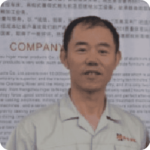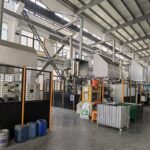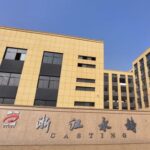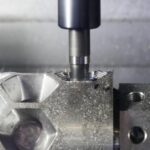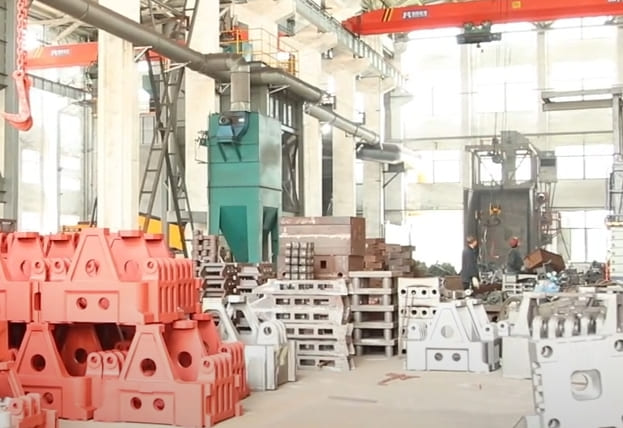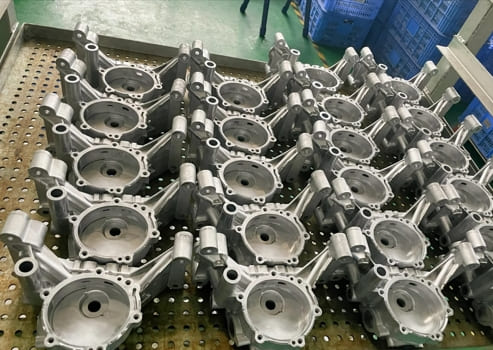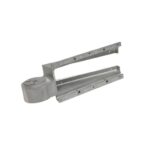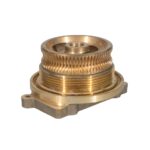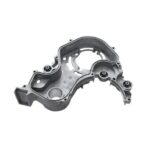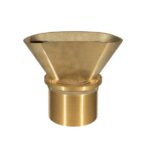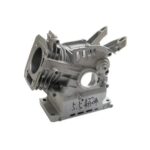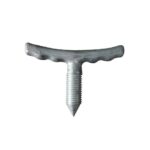When I review tooling issues, “shrinkage surprise” still ranks first. Aluminum changes volume twice—once when it freezes, again as it cools to storage temperature—and each phase steals microns that your customer’s gauge will find. After two decades of chasing those microns, I have boiled the math into a short playbook you can copy, verify with your own CMM, and trust on the next million shots. Nothing here is marketing fluff; the numbers come from actual cavity scales and inspection reports sitting in my archive.
The Two Shrinkage Phases You Must Track
Liquid aluminum loses volume the instant it solidifies, typically just over one percent for most Al-Si alloys. The casting then keeps shrinking as it drops from ~ 580 °C metal temperature to the workshop’s 20 °C ambient, adding roughly 0.6 % per 100 °C. High-pressure die-casting reduces visible sink but doesn’t change lattice physics, so ignoring either phase turns “first-shot-good” into “first-shot-regrind.” A380 at 50 °C die-open still cools another 130 °C before the inspector touches it—enough for 0.8 mm loss on a 100-mm span if you forget the math.
Quick-Reference Shrinkage Factors by Alloy
Below are the design factors my toolroom starts with. They already include solidification plus a 200 °C cool-down to room temperature. We fine-tune after first-shot CMM, but these baseline numbers land within ±0.15 mm on 95 % of new tools.
| Alloy | Solidification (%) | Thermal (%) | Total Factor (%) | Practical Notes |
|---|---|---|---|---|
| A360 | 1.05 | 0.55 | 1.60 | Preferred for auto housings, good fluidity |
| A380 | 1.10 | 0.60 | 1.70 | Global workhorse, watch Mg for solder |
| ADC12 | 1.00 | 0.55 | 1.55 | Asia standard; thin-wall phone bodies |
| 413 | 0.95 | 0.65 | 1.60 | High Si, naturally low porosity |
| A356 (gravity) | 1.30 | 0.70 | 2.00 | Lower fill pressure means larger factor |
Step-by-Step Shrinkage Calculation Example
A 200 mm motor-mount center distance in A380 must fit a ±0.05 mm bearing stack on the final part. Using the 1.70 % factor, I scale that span to 203.40 mm inside the CAD cavity (200 × 1.017). Because a rib creates a local hot spot, we add 0.05 % there, bumping that pocket to 203.50 mm. During sampling we apply squeeze-pin pressure, so we subtract 0.03 % on the opposing wall to avoid an oversize bore. The first-shot CMM came back at 200.02 mm—close enough that a 0.02 mm EDM skim nailed spec.
CAD Modelling Tips to Apply Shrinkage Efficiently
Scaling an entire solid once is easy; revising it after three ECOs is agony if you mix shrinkage and draft. I put global scale at the top of the feature tree, then handle local tweaks—hot-spot bosses, rib ends, slide pockets—in child features with clear notes. Slides often need independent X-Y scaling because cavity steel warms unevenly. Keep those tweaks in a separate folder so your CAD jockey can toggle them for a quick flat-pattern export.
Measuring Actual Shrinkage on First Shots
We clamp a cooled-down casting in the CMM 30 minutes after ejection, then again at 24 hours, and finally at one-week ageing. On A360 housings the extra creep averages 0.04 mm per 100 mm span in the first day and stabilises by day three. Plotting this delta against die-surface thermocouple logs lets us tighten future factors without wild guesswork. For shop-floor feedback we use dial-indicator fixtures that track the two most critical centers while the casting is still warm—five-second check, two data points per cycle.
Common Shrinkage Miscalculations and Practical Fixes
- Slide-face friction ignored: casting drags steel, losing 0.1 mm—add graphite lube grooves or scale slide face +0.05 %.
- Hot-spot ribs cool last: local sink marks—insert chill pins or thin the rib by 0.3 mm.
- Small bosses overscaled: features under 4 mm vanish after machining—apply only 50 % of global factor to micro geometry.
Each of these lessons cost me at least one emergency EDM booking; you can skip the tuition.
Shrinkage math is a two-line formula, yet skipping solidification or geometry modifiers still wrecks launch schedules. Start with the alloy factor, layer on hotspots, verify with CMM, and your first-shot acceptance meeting turns into an early lunch. Need the Excel calculator that automates these numbers and prints a tidy spec sheet for your toolmaker? Email yongzhucasting@gmail.com—I’ll send the file and walk you through a sample part faster than our furnace reaches pouring temp.
Quick FAQ
Does vacuum assist change shrinkage?
Only in hotspots where porosity is cut; factor shifts less than 0.02 %.
Will bead-blast texture shift dimensions?
Add 5–7 µm per face—texture builds out, not in.
Can one global scale cover 3 mm ribs and 15 mm bosses?
Use global for the bulk, then local tweaks on extremes; one size rarely fits all.
Searching for High-Quality for Cast Aluminum Parts Supplier?
You’ve come to the right place! Yongzhu Casting is a certified die casting manufacturer with over 20 years of expertise in the industry.
We have successfully completed numerous die casting projects for Aluminum casting parts, particularly in your industry.

Zhejiang Yongzhu Casting Technology Co., Ltd.
Location: Zhejiang, China
Company type: Manufacturers, Producers, Wholesalers
Year Founded: 2004
Main Products: Aluminium die casting, Mold Making, Die Casting, Sand Casting, Gravity Casting
Leading Chinese producer Yongzhu Casting is formerly known as Hangzhou Higer Metal Products Co., Ltd., was established in 2004.
With 20 years of experience in the industry, we are a specialized manufacturer in Aluminum casting and Machining.
Our products are widely used in various applications such as Automotive, Energy, Lighting, Medical, Home Furnishings, Machinery & Equipment etc. Below are our advantages:
Design Review & DFM Support
Our professionals will evaluate your designs and provide suggestions for cost savings. Additionally, we offer Design for Manufacturing (DFM) assistance and conduct mold flow analyses to facilitate efficient production.
State-of-the-Art Manufacturing Equipment
Our facility is equipped with advanced hot-chamber and cold-chamber die casting machinery for aluminum and zinc production.
We also utilize high-precision CNC machines in a temperature-controlled workshop, featuring 3-Axis, 4-Axis and 5-Axis setups to manage any project you have.
Rigorous Quality Control Measures
Our dedicated quality control team ensures that all parts meet the highest standards of quality and consistency. We employ high-accuracy measurement instruments, including CMM, spectrometers, and X-ray detectors.
Comprehensive Surface Treatment Options
We provide a variety of surface finishing techniques for your precision die casting components. Our in-house services include cleaning, polishing, anodizing, shot blasting, and painting.
Flexible Project Acceptance
While larger manufacturers often shy away from low-volume projects, and smaller ones may struggle with quality, Yongzhu Casting stands apart. We prioritize customer satisfaction and willingly accept high-mix, low-volume projects like yours.


